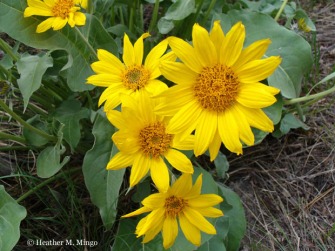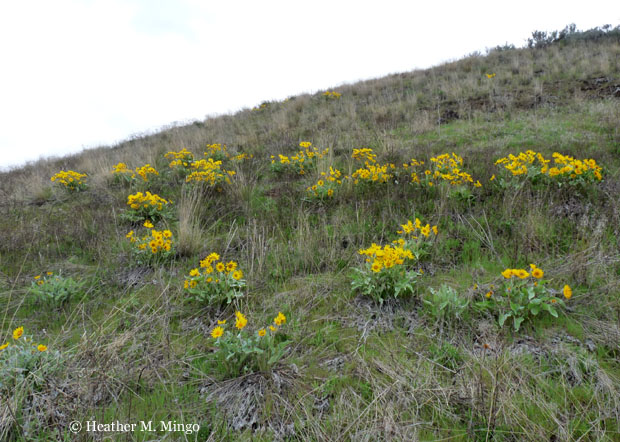Balsamroot is a wild sunflower that grows on dry grassy slopes here early in the spring. Local folklore says that when the balsamroot blooms, it is time for the rattlesnakes to come out of their winter dens. But for me, seeing a hillside covered with these golden yellow flowers is one of my favourite sights of spring and a promise that the dull grey days of winter are well and truly gone.
 Sometimes called “spring sunflower,” balsamroot’s full name is arrow-leaved balsamroot (Balsamorhiza sagittata), for the shape of its long, pale green leaves and the balsam-like odour of its woody taproot. This taproot reaches deep into the soil, which allows the plant to find moisture on warm, dry hillsides, and may also help to stabilize the slope and prevent erosion. Balsamroot’s seeds feed rodents and birds, while deer and elk graze on the leaves. It grows on open hillsides, rolling sagebrush grasslands, and in open pine forests from British Columbia south to California and as far east as South Dakota.
Sometimes called “spring sunflower,” balsamroot’s full name is arrow-leaved balsamroot (Balsamorhiza sagittata), for the shape of its long, pale green leaves and the balsam-like odour of its woody taproot. This taproot reaches deep into the soil, which allows the plant to find moisture on warm, dry hillsides, and may also help to stabilize the slope and prevent erosion. Balsamroot’s seeds feed rodents and birds, while deer and elk graze on the leaves. It grows on open hillsides, rolling sagebrush grasslands, and in open pine forests from British Columbia south to California and as far east as South Dakota.
For native peoples of this region, balsamroot was an important food source. All parts of the plant are edible, from the leaves (best when they’re young) to the thick taproot (roasted) and the seeds (eaten raw, or dried and pounded into a flour). The roots and leaves were also used medicinally for different purposes. For most people today, however, I feel that balsamroot may be most important as a plant that can teach us about our local seasonal cycles.

How do you tell the seasons? Today, our calendars tell us that spring begins on the equinox, March 20 (or September 23 in the southern hemisphere), but nature is not quite as tidy as that. The weather can vary dramatically from year to year, and even within a year, it is easy to have a few weeks of warm weather followed by a month of rain. Where I live, it’s even possible to see snow falling on the equinox. But plants use temperature, light, and moisture as their seasonal cues. Once enough warm days have passed, the plant will begin to grow (the exact cue used will vary: for example, in the deserts further south, the presence of moisture may be more important in triggering plant growth). By observing the growth of plants, we can appreciate the unique seasonal patterns of our local landscape and climate, and have a surer way of marking the change of the season than a date on the calendar.
Arrow-leaved balsamroot, being a large, showy plant that blooms early in the year, is an obvious sign of spring. Yet it is also a less obvious sign of spring turning to summer. By blooming and completing most of its growth in the spring, balsamroot avoids the dry, hot months of summer. After blooming, the plant begins to wither, the large leaves drying up and becoming crisp and brown. Once such a noticeable part of the landscape, the plants are then easy to miss and I can find myself forgetting that they were even there. In a region where summer’s heat and dryness can be as much of a challenge as winter’s cold, both blooming early and growing a thick taproot (better to reach and store moisture) are adaptations that allow the balsamroot to thrive. As the last of the balsamroot’s flowers fade away in spring, the season is starting to turn towards summer as the days lengthen and approach the summer solstice.
Observing the passing of the seasons is an activity that I never grow tired of. It reminds me of the constancy of change, and the cycles of growth, death, and decomposition often echo cycles in my own life. Now, in the final days of winter, I am still looking forward to once again seeing the golden yellow flowers of balsamroot covering the hillsides. And as unlikely as it may seem amid the dark grey skies of winter, I know that day will come. And that is a good thing.
What plants and animals do you watch for as signs of the season in your environment?
~~~
“B is for Balsamroot” is part of a series of posts exploring plants, animals, and other beings important in my life. Previous post: A is for Apple. Next post: C is for Chickadee.
